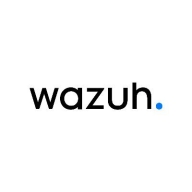

Microsoft Defender XDR and Wazuh compete in the enterprise security software category, offering different approaches to threat detection and response. Microsoft Defender XDR holds an edge with its integration into the Microsoft ecosystem, providing robust threat protection and streamlined user experience, but comes at a higher cost. Wazuh provides a flexible open-source solution, which is more cost-effective for budget-conscious organizations.
Features:Microsoft Defender XDR delivers strong threat protection through integrated Microsoft tools, boasting nearly 95% coverage in threat detection. It integrates well with Microsoft 365, security compliance portals, and Azure, offering email scanning, endpoint protection, and network security. Wazuh emphasizes open-source flexibility, offering features such as PCI DSS compliance, host-based intrusion detection, and integration with AWS services. It also supports log monitoring and indexing services, making it a versatile option for many organizations.
Room for Improvement:Microsoft Defender XDR can improve its third-party integration, enhance its dashboard for better user experience, and simplify its licensing model to reduce cost ambiguity. Better communication on updates would also alleviate user confusion. Wazuh could enhance its threat intelligence capabilities, improve scalability and automatic response actions, and offer better direct support.
Ease of Deployment and Customer Service:Microsoft Defender XDR is noted for easy deployment within the Microsoft ecosystem, seamlessly integrating into hybrid and public cloud environments. It leverages Microsoft’s global support network, although response times can vary. Wazuh, while flexible, primarily suits on-premises and hybrid cloud deployments. Its open-source nature often requires reliance on community support, which can be challenging for some users lacking structured support.
Pricing and ROI:Microsoft Defender XDR is often seen as costly, particularly for smaller businesses, due to its complex licensing and cost unpredictability. Its comprehensive features can, however, provide significant ROI through improved security and efficiency. Wazuh presents a cost-effective solution, being open-source, and requires minimal direct expenses beyond support and infrastructure. Organizations need to be prepared to invest in integration and support to fully leverage its capabilities.
We can quarantine and isolate a device within minutes.
Microsoft Defender XDR has saved me at least 50% of my time.
Ever since we turned on the M5 feature set back in June, we have seen a reduced number of potentially malicious clicks and faster alerting when incidents occur.
I have seen value in security cost savings with Wazuh, as using proprietary EDR versions could save us substantial money.
You get stuck in low-level support for way longer than you should, instead of them escalating the issue up the chain.
It's critical to escalate SEV B issues immediately to a domestic engineer.
Once issues are escalated to the second or third layer, the support is much better.
They responded quickly, which was crucial as I was on a time constraint.
We use the open-source version of Wazuh, which does not provide paid support.
The documentation is good and provides clear instructions, though it's targeted at those with technical backgrounds.
Microsoft Defender XDR shows tremendous scalability, much more so than on-premises solutions.
Microsoft Defender XDR scales pretty well.
It is suitable for enterprise-level deployment but has room for improvement.
It can accommodate thousands of endpoints on one instance, and multiple instances can run for different clients.
Currently, I don't see any limitations in terms of scalability as Wazuh can still connect many endpoints.
Scalability depends on the configuration and the infrastructure resources like compute and memory we allocate.
The service has remained consistently online, with any issues isolated to specific components, suggesting a well-designed and modular architecture.
The services within our ecosystem have been reliable, meeting their SLAs.
It provides high-fidelity signals.
The stability of Wazuh is strong, with no issues stemming from the solution itself.
The stability of Wazuh is largely dependent on maintenance.
The indexer frequently times out, requiring system restarts.
The licensing process needs improvement and clarification.
Improvements are needed in automated response capabilities.
Some inconsistencies exist between blades, which could be improved for a more seamless user and UI experience.
Machine learning is needed along with understanding user behavior and behavioral patterns.
The integration modules are insufficiently developed, necessitating the creation of custom integration solutions using tools like Logstash and PubSub.
I think Wazuh should improve by introducing AI functionalities, as it would be beneficial to see AI incorporated in the threat hunting and detection functionalities.
There are certainly savings when using Microsoft Defender XDR, which can range from 30%, 40%, and even up to 50%.
I would rate the pricing as eight out of ten, indicating it is a reasonable cost for the product.
Microsoft purposefully obfuscates this through marketing ploys to hide costs.
Wazuh is completely free of charge.
I would definitely recommend Wazuh, especially considering Fortinet's licensing model which is confusing and overpriced in my opinion.
Totaling around two lakh Indian rupees per month.
With Microsoft threat intelligence information, it detects various types of threats, including insider attacks, malicious content, and data exfiltration.
This allows us to secure our systems in advance and proactively improve security, rather than waiting for incidents to occur.
Once we have it on the security dashboard, we can see a real-time storyline.
Wazuh is a SIEM tool that is highly customizable and versatile.
The system allows us to monitor endpoints effectively and collect security data that can be utilized across other platforms such as SOAR.
With this open source tool, organizations can establish their own customized setup.
| Product | Market Share (%) |
|---|---|
| Microsoft Defender XDR | 5.9% |
| Wazuh | 10.2% |
| Other | 83.9% |


| Company Size | Count |
|---|---|
| Small Business | 46 |
| Midsize Enterprise | 23 |
| Large Enterprise | 37 |
| Company Size | Count |
|---|---|
| Small Business | 26 |
| Midsize Enterprise | 15 |
| Large Enterprise | 8 |
Microsoft Defender XDR is a comprehensive security solution designed to protect against threats in the Microsoft 365 environment.
It offers robust security measures, comprehensive threat detection capabilities, and an efficient incident response system. With seamless integration with other Microsoft products and a user-friendly interface, it simplifies security management tasks.
Users have found it effective in detecting and preventing various types of attacks, such as phishing attempts, malware infections, and data breaches.
Watch the Microsoft demo video here: Microsoft Defender XDR demo video.
Wazuh offers comprehensive security features like MITRE ATT&CK correlation, log monitoring, and cloud-native infrastructure. It ensures compliance and provides intrusion detection with high scalability and open-source flexibility, ideal for businesses seeking robust SIEM capabilities.
Wazuh stands out in security information and event management by providing efficient log aggregation, vulnerability scanning, and event correlation against MITRE ATT&CK. Its capability to integrate seamlessly with environments, manage compliance, and monitor files makes it suitable for cloud-native infrastructures and financial sectors. Despite its technical support needing enhancement and opportunities for improving AI integration and threat intelligence, its open-source nature and cost-effectiveness make it appealing. Users can leverage custom dashboards powered by Elasticsearch for precise data analysis, even though there is a desire for a more user-friendly interface and better enterprise solution integration. Deployment may be complex, but its features contribute significantly to fortified security postures.
What are the essential features of Wazuh?Industries like finance and cloud infrastructure heavily utilize Wazuh for its security strengths. By monitoring endpoints and ensuring compliance with frameworks, companies can improve security posture and swiftly detect anomalies. The platform's focus on event correlation and alerts for security incidents is particularly beneficial.
We monitor all Extended Detection and Response (XDR) reviews to prevent fraudulent reviews and keep review quality high. We do not post reviews by company employees or direct competitors. We validate each review for authenticity via cross-reference with LinkedIn, and personal follow-up with the reviewer when necessary.